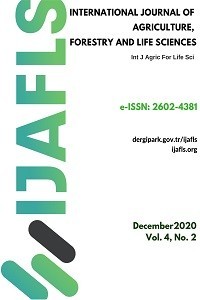AGRICULTURAL DEVELOPMENT LED INDUSTRIALIZATION IN ETHIOPIA: STRUCTURAL BREAK ANALYSIS
AGRICULTURAL DEVELOPMENT LED INDUSTRIALIZATION IN ETHIOPIA: STRUCTURAL BREAK ANALYSIS
ADLI Structural Break, Zivot-Andrew, Bai-Perron, Ethioppia,
___
- Diao, X., 2010. Economic Importance of Agriculture for Sustainable Development and Poverty Reduction : The Case Study of Ethiopia, IFPRI.
- Gebre-selassie, A., Bekele, T., 1999. A Review of Ethiopian Agriculture : Roles , Policy and Small-scale Farming Systems.
- GRIPS, 2009. Democratic Developmentalism and Agricultural Development Led Industrialization: the GRIPS Development Forum (GDF) for the first round of policy dialogue between Ethiopia and Japan in June 2009.
- Lulit, M., Lemma, S., Behuta, B., 2010. Public Spending, ADLI, and Alternative Scenarios for Ethiopia: A Dynamic CGE Framework Analysis, Addis Ababa, Ethiopia, in: 8th PEP General Meeting Dakar, Senegal-June 2010.
- Mellor, J., Dorosh, P., 2009. Agriculture and Exonomic Transformation of Ethiopia, ESSP-IIDiscussion Paper 12, IFPRI, Addis Ababa.
- Ministry of Finance and Economic Development, 2013. Annual progress Report of the GTP (Growth and Transformation Plan).
- MoFED, 2005. MoFED: Ethiopia: Building on Progress: A Plan for Accelerated and Sustained Development to End Poverty (PASDEP) (2005/06-2009/10), Ministry of Finance and Economic Development (MoFED), Federal Democratic Republic of Ethiopia, Addis Ababa.
- MoFED, 2002. MoFED ). Ethiopia: Sustainable Development and Poverty Reduction Program, Ministry of Finance and Economic Development (MOFED), Federal Democratic Republic of Ethiopia (FDRE), Addis Ababa, Ethiopia.
- MoFED2015/16-2019/20: Draft Growth and Transformation Plan, (GTP II), (2015/16-2019/20) (Unpublished draft, 2015).
- MoFED, 2010/11-2014/15: Ethiopia, Ministry of Finance and Economic Development Growth and Transformation Plan, 2010/11-2014/15,Volume1: Main Text (Addis Ababa, 2010) Available from http://www.mofed.gov.et/English/Pages/Home.aspx.
- UNDP, Human Development Report 2015: Work for Human Development (New York, 2015). Available from http://www.undp.org.
- World Bank, 2016. The Growth Acceleration and How to Pace It.
- World bank data File. Available online: https://data.worldbank.org/indicator/NY.GDP.MKTP.KD.ZG?locations=ET (accesseed on 2/16/2019)
- Yayın Aralığı: Yılda 2 Sayı
- Başlangıç: 2017
- Yayıncı: Volkan OKATAN
Catherine ARRADAZA, Ma. Lourdes O. CEDO, Rocelie R. ZARA, Rachel Ann GONZAGA
INVESTIGATIONS ON SOME PROPERTIES OF CURRANT AND GOOSEBERRY VARIETIES GROWN IN ORGANIC CONDITION
POLYGENIC RESISTANCE OF IMPROVED RED PEPPER LINES TO PHYTOPHTHORA CAPSICI
Saadet Toğaç, Sermin Akıncı, Bekir Bülent Arpacı
EFFECT OF SEAWEED EXTRACT (SE) ON SEED GERMINATION CHARACTERISTICS OF WHEAT IN SALTY CONDITIONS
EFFECTS OF CALCIUM ASCORBATE AND CALCIUM LACTATE ON QUALITY OF FRESH-CUT PINEAPPLE (Ananas comosus)
Roden TROYO, Antonio Jr. ACEDO
AN EVALUATION OF NITROGEN FERTILITY MANAGEMENT IN COMMERCIAL POTATO FIELDS
EFFECTS OF GLOBAL WARMING ON ANIMAL BREEDING
Sibel ALAPALA DEMİRHAN, Nuray ŞAHİNLER
THE USING OF TREES IN HITTITE RELIGIOUS RITUALS
DETERMINATION OF SUITABLE AREAS OF APPLE (MALUS DOMESTICA) CULTIVATION WITH AHP AND GIS TECHNIQUES
Namık Kemal SÖNMEZ, Sahriye SÖNMEZ, Mesut ÇOŞLU, Hasan Raşit TÜRKKAN
